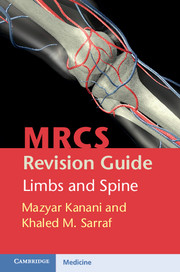3 - Surgical pathology
from Section 1 - Basic science
Published online by Cambridge University Press: 05 August 2015
Summary
Bone tumours
Which are more common, primary bone tumours or metastatic bone tumours?
Metastatic bone tumours are the commonest tumour of the skeletal system, usually deposited in bone. They are usually of an epithelial origin, or occasionally sarcomas, and metastasize to bone.
What are the five common malignant neoplasms in bone (in order of frequency)?
• Breast: most commonly metastasize to ribs, thoracic vertebrae, clavicles,
• Prostate: reaches bone by venous spread, and is most common in the lumbosacral spine and pelvis,
• Bronchus,
• Kidney,
• Thyroid.
Arterial spread may result in deposition anywhere in the skeleton but is most common in flat bones, the vertebrae and the proximal ends of the humerus and femur.
What is the commonest malignant neoplasm arising in bone?
Myeloma: it originates in the haemopoietic tissue of red marrow. It is occasionally solitary but often found to be multiple. It tends to occur in patients past the fifth decade and commonly affects the pelvis and spine. It forms about half of primary malignant tumours arising in bone. The tumour cells resemble plasma cells.
What is the commonest malignant neoplasm derived from bone tissue?
Osteosarcoma: it arises from bone cells that are undifferentiated and capable of forming musculoskeletal tissue, such as bone, cartilage and collagenous tissue. It usually occurs under the age of 30 with a male dominance and usually in the metaphysis of long bones. A quarter of primary malignant bone tumours are osteosarcomas. Chondrosarcomas, arising from chondroblasts producing chondroid and collagen (not bone), make up 15%.
- Type
- Chapter
- Information
- MRCS Revision Guide: Limbs and Spine , pp. 51 - 69Publisher: Cambridge University PressPrint publication year: 2012



